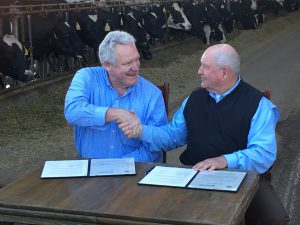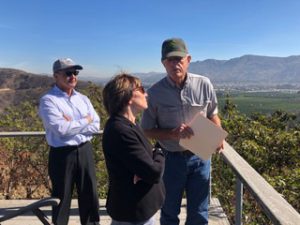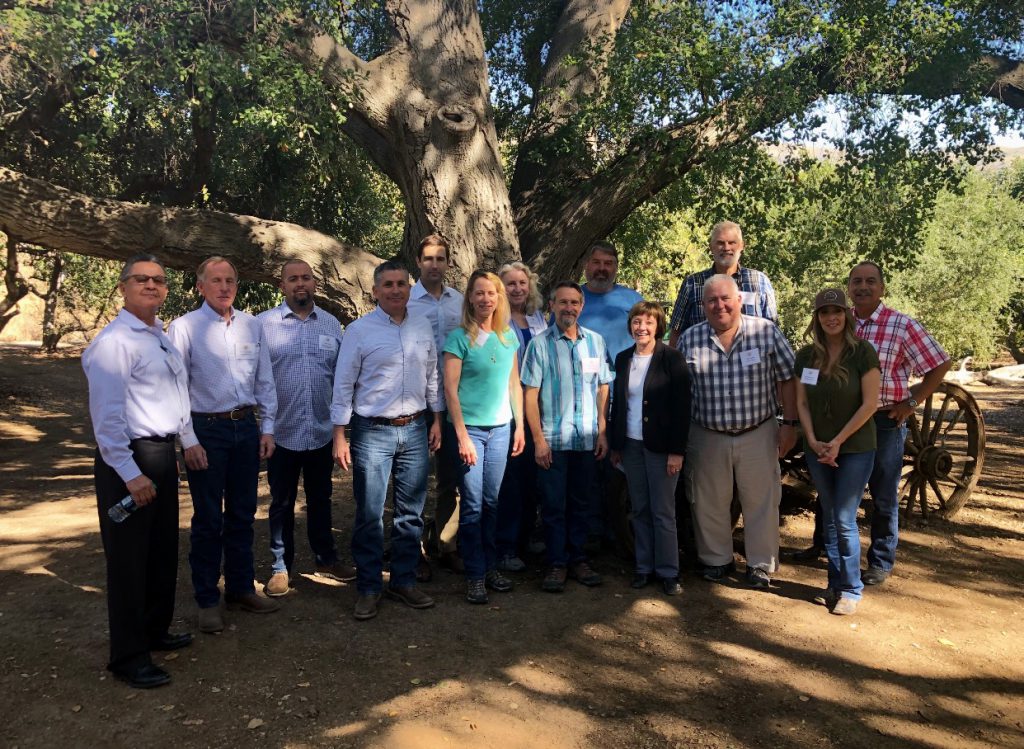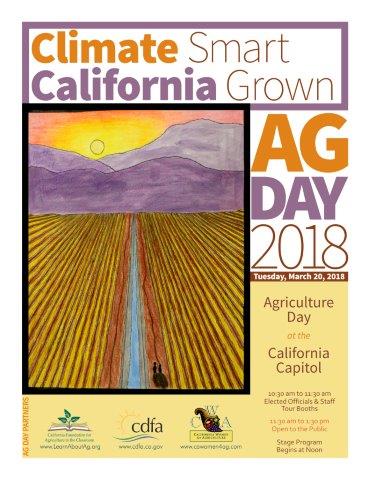
By Leah Shaffer
This past holiday season, I met the farmer who raised my Thanksgiving turkey. I didn’t go to his farm, though, nor did I run into him at a farmers’ market. Rather, I tracked him down using a blockchain, the same technology that underpins bitcoin and other so-called cryptocurrencies.
Mike Neal was just as delighted to talk to me as I was to find him. “I’m just thrilled that you would buy a turkey that came off my farm,” he told me over the phone. When I mentioned that I purchased his turkey near St. Louis, Missouri, he was even more surprised. “I was just under the assumption that almost all of my turkeys were all sold in Texas.”
Under the current agricultural system, it’s the norm for both the farmer and consumer to be disconnected. Neal raises flocks of 50,000 turkeys a couple times a year on his farm, outside of Crawford, Texas. The turkeys are owned and hatched by Cargill, and up until recently, there wouldn’t have been an easy way for the consumer or farmer to follow that vast food chain. The blockchain changes that.Last year, when a flock of newborn turkeys made the journey to Neal’s farm, the occasion was marked in a digital file or block of information. The baby turkeys, called poults, spent just over 90 days on the farm roaming their turkey house to drink and eat and growing to about 15 pounds without the aid of growth hormones or growth-inducing antibiotics.
Then the flock was sent to the processor, and once again, a new block was created marking the processor’s name, its location, and the turkey’s arrival. This new block was linked to the previous one in such a way that the information was, for all intents and purposes, immutable. Finally, my turkey became one of the many birds filling store freezers last Thanksgiving.
While blockchains were first created to underpin the bitcoin cryptocurrency, the technology is spreading to the far corners of our economy. Banks like Goldman Sachs and UBS are exploring blockchain technology and how it might apply to existing financial markets, and companies like IBM and GE are looking to apply it to diverse industries including healthcare and electricity. Blockchains have the potential to find their way into just about any transaction that requires verification, which represents a significant portion of the world’s economy.
Behind the Blockchain
Supply chains, like those that raised, processed, and sold my turkey, are well-suited to blockchains because, at heart, they consist of a series of transactions. Trust in those transactions is part of what makes a supply chain valuable, just like with currencies like bitcoin.
On some level, blockchains and the trust they inspire are what gives bitcoin and other cryptocurrencies their value. In a blockchain, transactions are recorded to an open ledger that everyone can see. Once entries have been made to the ledger, it’s extraordinarily difficult to change them—practically impossible given today’s computing power.The immutable nature of blockchain relies on the fact that each transaction has its own digital signature that’s then cryptographically crunched into what’s known as a hash. Each transaction or block is represented by one of these hashes, and each subsequent block contains the hash of the previous one. If someone were to try to alter the blockchain—say, to steal bitcoin or falsify information about the way turkey was raised—they would have to alter that block and all of the blocks that came after it to ensure that the hash record lines up. The amount of work required to do that is substantial enough to make a blockchain essentially impervious.
Blockchains can also be transparent in the same way old library cards were: In those cards, people could see a list of the previous patrons who checked out the book. In a blockchain transaction, as each party passes the product and data down the chain, they are confirming a certain truth about what happened with that item.
Transparent Transactions
For increasingly savvy consumers, blockchains offer a chance to shed light on otherwise opaque systems like agriculture.
The labels on a package of ground beef—“grass-fed,” “all-natural,” or “antibiotic-free”—can be surprisingly difficult to trace. Even the small number of large corporations that control most of the meat industry can have a hard time tracking down all of that information, says Cody Hopkins, the general manager of Grass Roots Cooperative, a farmer-owned co-op based in Arkansas.
In our modern food chain, there are many steps from farm to table, he says. “There is maybe one entity in that whole chain that might have the whole story of where that product started and what happened to it along the way before it gets on the supermarket shelf,” Hopkins says.A large meat producer might know the whole story of that food chain, he added, although it does take them quite a while to piece together because different food distributors use different accounting systems—everything from paper receipts to tracker chips and bar codes.
“Each of these steps along the way often operate in silos,” Hopkins says.
Grass Roots turned to blockchains to offer a way around those silos. Grass Roots started using a blockchain this August for all the chicken products, then added pork and turkey in the fall. Their farmers and processors use an app from a startup named Provenance, which applies blockchains to food systems. In 2016, for example, Provenance worked with tuna fishermen in Indonesia to record their catches and begin a blockchain that proves they receive fair wages and the seafood was sustainably fished. The fishermen all have phones, and they register a catch by sending a simple text.
Like the fishermen, at Grass Roots, each entity along the way—the farmer, processors, etc.—have access to the platform. When farmer receives a batch of chickens, they register it on a blockchain. When the farmer sends it to processor, they transfer that asset to the processor, but it doesn’t show up on the blockchain until the processor is notified, receives the chickens, and confirms this unique transaction. That continues until the processed chickens are mailed directly to consumers, who can then review each step via the blockchain.Hopkins says that Grass Roots hopes to add price transparency information to the block chain, such as the cost of grain and labor, so consumers could see how much a farmer or processor nets in each transaction. This would be a huge change for the agriculture industry. As it stands, consumers and most farmers under contract to meat producers have no idea what causes the price fluctuations in their market. “Farmers don’t know if they’re getting a fair shake from these companies,” Hopkins says.
With more transparency, consumers and farmers can learn the costs of each step involved in meat production. It could also reveal weak links in the chain. “That transparency has a lot of benefits including food safety,” Hopkins adds. “It takes the mystery out of the meat system, really.”
Food Safety
For those involved in the food system, safety improvements are the main draw of blockchain. And from the perspective of food safety experts, that could be a very beneficial change. The patchwork system of global food distribution not only makes it hard to track labor and environmental concerns, but slows the detective work of finding the source of an outbreak of food-borne illness. “The trace back of trying to find the source of the contaminant is still difficult,” says Amy Kircher, director of the Food Protection and Defense Institute. “We don’t have an incredibly transparent food safety system.”
As it stands now, if local officials identify a foodborne illness outbreak, they can load that information to a central database overseen by the CDC. The database allows health officials to find patterns in illness outbreaks that could help them determine the source and extent of the problem. The challenge is that “you have to have a large amount of cases before any outbreak is even identified,” Kircher says. And even then, finding the original source is a “laborious process,” she adds.
To see how the blockchain could streamline recalls, imagine you unknowingly bought a contaminated chicken pot pie at the store. Every ingredient came from different suppliers, different processors, and different farms. Some of those entities may use sophisticated databases to track transactions, while others may still operate using paper receipts. Finding the infectious culprit would mean chasing down those receipts, calling processors, retailers, all of which takes time.But with a blockchain, every time an ingredient was processed or delivered, someone has to log its progress. Should an outbreak occur, investigators would only have to look at the blockchain to trace the source. It would be the central, canonical source of information about where each ingredient traveled from farm to table. Such a central repository would also speed recalls, saving lives. Kircher and her colleagues at the Food Protection and Defense Institute could also use a blockchain to anticipate possible targets for food fraud or vulnerabilities in a distribution system.
“That really helps, from a food safety perspective,” Kircher says.
Blockchain Everywhere?
For blockchain to have an impact, more people and companies will have to be connected. More major corporations are going to have sync up their distribution systems, and more small farms need to participate. That’s beginning to happen. Retailers such as Walmart and Kroger along with their suppliers, including Dole and Tyson Foods, are partnering with IBM to create a pilot project using blockchain.
Both big producers and small farms are seeing blockchain as an opportunity. For large corporations, use of the technology can garner more trust from consumers. And for smaller operations, the addition of a transparent supply chain enables farmers and consumers to get a “fair shake,” as Hopkins says.
The world of cryptography seems to be about as far as you can get from the work of raising birds, but farmer Mike Neal is not intimidated by it. “As far as I’m concerned, what Cargill is doing is just a refined process of connecting, me, a grower, with you, a consumer,” he says. “It enables you to actually say, ‘It’s a real person out here growing these turkeys.’ ”
Link to article

















